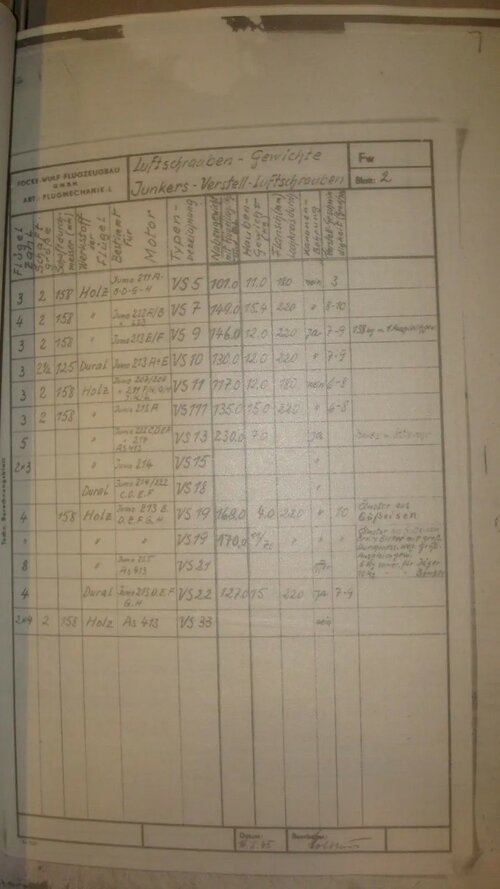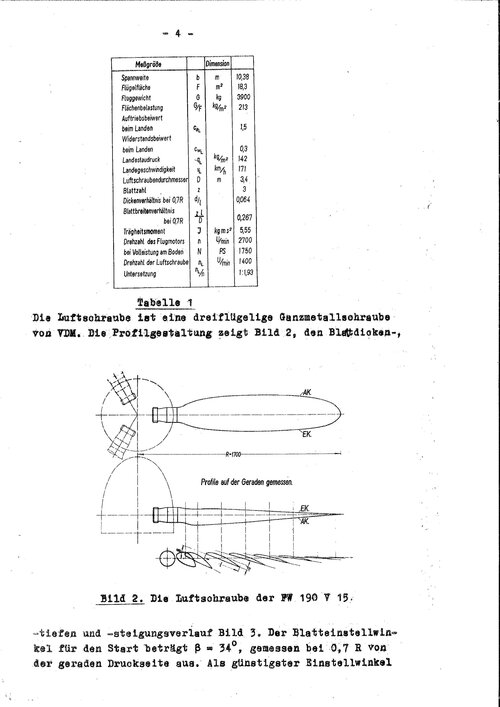You are using an out of date browser. It may not display this or other websites correctly.
You should upgrade or use an alternative browser.
You should upgrade or use an alternative browser.
German WW2 propellers
- Thread starter CJGibson
- Start date
Edwest wrote:
A good book about the development of propellers.
I would say a "not so good book about the development of propellers". It shows a remarkable chauvinistic approach to this technology, centering it`s development in the US and neglecting european achievements. Per example, the Soviet Union`s work in this technology is completelly absent from this book.
I`m Still waiting for a good book about the development of propellers! Soviet developments would be most welcome.
I am not totally disagreeing with your broader conclusions that the book has very little on German developments, but I would be a bit cautions about saying its not "A" good book on propellors.
I was at the Aircraft Engine Historical Society convention meeting in Dayton Ohio in person when the author Jeremy Kinney came and made us a presentation on his book. He freely admitted he had not had the time and money to make a huge trip and research effort to look into German developments, but I dont think this makes the rest of his book "void".
With my own book comig out soon, I really dont think people appreciate how hard it is to write some sort of "definitive global complete" history of any topic if you plan to actually use proper primary sources. I must have spent... I dont know... maybe... £25,000 and 5 years researching my book, and I had to give up on Japan and Russia because its simply financially and logistically impossible. Not to mention nobody will publish a 1000page treatise these days. If you write one, its commercially unviable.
I spent several months making contacts in Russia to try to research it, and I would have needed at least £8000 and six months to have made a serious effort to do so, before you even add in the cost of a translator/guide/fixer which you need to go to places like that.
I`m not making excuses for poor research,or poor conclusions or willful ignorance,but its a very useful book and whilst another is required to complete the story, I personally recommend anyone interested in propellors buys it.
Edwest wrote:
A good book about the development of propellers.
I would say a "not so good book about the development of propellers". It shows a remarkable chauvinistic approach to this technology, centering it`s development in the US and neglecting european achievements. Per example, the Soviet Union`s work in this technology is completelly absent from this book.
I`m Still waiting for a good book about the development of propellers! Soviet developments would be most welcome.
I am not totally disagreeing with your broader conclusions that the book has very little on German developments, but I would be a bit cautions about saying its not "A" good book on propellors.
I was at the Aircraft Engine Historical Society convention meeting in Dayton Ohio in person when the author Jeremy Kinney came and made us a presentation on his book. He freely admitted he had not had the time and money to make a huge trip and research effort to look into German developments, but I dont think this makes the rest of his book "void".
With my own book comig out soon, I really dont think people appreciate how hard it is to write some sort of "definitive global complete" history of any topic if you plan to actually use proper primary sources. I must have spent... I dont know... maybe... £25,000 and 5 years researching my book, and I had to give up on Japan and Russia because its simply financially and logistically impossible. Not to mention nobody will publish a 1000page treatise these days. If you write one, its commercially unviable.
I spent several months making contacts in Russia to try to research it, and I would have needed at least £8000 and six months to have made a serious effort to do so, before you even add in the cost of a translator/guide/fixer which you need to go to places like that.
I`m not making excuses for poor research,or poor conclusions or willful ignorance,but its a very useful book and whilst another is required to complete the story, I personally recommend anyone interested in propellors buys it.
Calum,
Thank you very much for your post. I work for a book publishing company (fiction), but research to gather real-world information is still required. We have a relatively large in-house book collection and I have been the researcher here for some decades. That said, I really don't think the average reader of historical subjects considers more than the finished book, almost regardless of the size of the "I wish to thank my contributors" section, and the list of documents/sources portion. Some do know but even for specialist literature like this for the Luftwaffe, 10, 20 or more years is not that uncommon to collect and turn documents into a cohesive and readable book.
Dan Sharp`s latest bookazine "Luftwaffe Secret Projects of the Third Reich" shows, in pages 012 & 013, work conducted by K. Mende within the AVA/Göttingen on a "air-train" intended for the Luftwaffe. Both "pusher" aircraft featured shrouded propellers.
Hello guys, I am looking for serious trader for my Arado Ar 96 single wooden propeller blade. It is from Luftwaffe's training aircraft used in WWII and it is still in very good condition.
Can you help me with my effort? Please, contact me here luborisko@yahoo.com.
Thanks.
Lubor
Can you help me with my effort? Please, contact me here luborisko@yahoo.com.
Thanks.
Lubor
Attachments
Regarding the original question, I recently read an article about propellers, somewhere... The gist of it was that the German did a good job increasing chord, but were probably bettered by the American who went to paddle tips and constant chords. Cuffs would have been useful for radial engines cooling.
I might be wrong but the British seemed to do less research that the U.S. (N.A.C.A.) or the German.
The author compared engines power but this would be easily side-tracked by planes aerodynamics.
Btw, the article, or post, mentioned that paddle tips necessitated a change in reduction ratio.
I might be wrong but the British seemed to do less research that the U.S. (N.A.C.A.) or the German.
The author compared engines power but this would be easily side-tracked by planes aerodynamics.
Btw, the article, or post, mentioned that paddle tips necessitated a change in reduction ratio.
The synchronization is one logical aspect, but also the German preference for shooting straight through the propeller hub. The German 3 blade propeller hub of the BF109 looks allready quite large, this is surly due to the fact, that the hub was designed to offer enough space for shooting through it. With four blades, there might have been the necessity to increase the diameter and the weight of the hub even moreRegarding contra-props, personally I think that for single-engined installations the greatest improvement comes from the vastly improved handling. Just read the Spitfire test report comparing contra-prop and single-rotation variants, there is huge difference in handling. With the contra-rotating propeller especially directional trimming changes were reduced to near nil. And it also allowed the use of full-power on take-off. Look at the take-off performance of a restored Mk. XIX Spit retrofitted with a contra-prop.
Personally I find the synchronization theory a very plausible for German devotion to 3-bladers.
OliverSedlacek
ACCESS: Confidential
- Joined
- 31 March 2022
- Messages
- 137
- Reaction score
- 157
Surely one of the most significant factors in practice is ground clearance as determined by undercarriage design. The F4U Corsair has a 3 blade large diameter prop because it has the legs from day one. The Spitfire didn't have the clearance, so more blades were the way forward.
From all this I'm inferring that the German planes had taller undercarriage.
From all this I'm inferring that the German planes had taller undercarriage.
1635yankee
Recovering aeronautical engineer
- Joined
- 18 August 2020
- Messages
- 523
- Reaction score
- 699
Or the German engineers accepted much greater blade chords (and higher loads on pitch change mechanisms), greater tip speeds, or poorer performance in some conditions due to insufficient blade areaSurely one of the most significant factors in practice is ground clearance as determined by undercarriage design. The F4U Corsair has a 3 blade large diameter prop because it has the legs from day one. The Spitfire didn't have the clearance, so more blades were the way forward.
From all this I'm inferring that the German planes had taller undercarriage.
Early propeller design book, in Russian.

 www.bookvica.com
www.bookvica.com

CALCULATION OF PROPELLER CONSTRUCTION Vozdushnye vinty: Teoriya vintovykh dvigatelei i sposoby ikh vychislenii / S frantsuzkogo N. Gvozdev i.e. Air Propellers: The Theory of Screw Engines and Methods of Its Calculation /
Sevastopol: tip. N.A. Kovaleva, 1910. Item #361 3 , 60 pp.: diagr. 22,5x16,5 cm. In original wrappers. Lacking back wrapper and spine, loose, tears and owner’s signature on the front wrapper, foxing and stains on the title page with small holes on the margin.First and only Russian translation...
Tonton-42
ACCESS: Secret
- Joined
- 10 May 2014
- Messages
- 356
- Reaction score
- 659
This forum on the propellers is absolutely exciting. It is worth remembering that the calculation of a propeller (as in fact everything that touches aeronautics) is a complex matter and does not suffer mediocrity. At my small level of model designer without other pretensions than my personal satisfaction, I confess my frustration of not being able to use propeller in scale ratio coherent with the cell using small thermal motors because they only very rarely have the reducer allowing this. Only the use of brushless electric motors seems to achieve this consistency ... Because what could be worse than flying a Mustang with a PT-17 propeller !?
NB : Just as a reminder (as a beotian I wouldn’t want to sound like a fool) the propellers of the B-29 Silverplate and some B-29 and B-29B were Custiss Electric reversible pitch at least on the internal engines it seems to me.
NB : Just as a reminder (as a beotian I wouldn’t want to sound like a fool) the propellers of the B-29 Silverplate and some B-29 and B-29B were Custiss Electric reversible pitch at least on the internal engines it seems to me.
Thunderchicken
ACCESS: Restricted
- Joined
- 4 February 2024
- Messages
- 1
- Reaction score
- 1
Where there are guns that fire through the propeller arc, the fewer blades / interruptions, the better.
Thanks for the extra info! The best visual information i managed to find myself was from here but its only the FW-190 prototype https://elib.dlr.de/82474/1/AK-2248.pdf
Then there is also more mathematical stuff like pitch distribution here https://elib.dlr.de/82684/
Only found vague information for the materials pointing to spruce being used and also with resin injected in certain areas
Then there is also more mathematical stuff like pitch distribution here https://elib.dlr.de/82684/
Only found vague information for the materials pointing to spruce being used and also with resin injected in certain areas
Attachments
Similar threads
-
-
-
-
Projects of the German Secret Flight Test Center at Lipetsk, USSR 1924-1933
- Started by Dynoman
- Replies: 37
-





